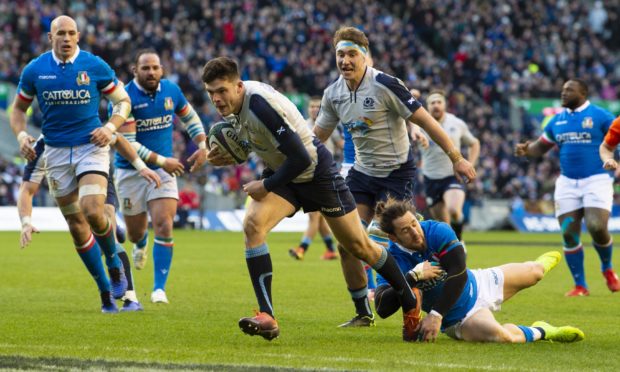They’re testing for the coronavirus using thermal imaging cameras at Rome’s airports, but they’ll be hard pressed to pick up any fever from Scottish fans after Gregor Townsend’s selection for Saturday’s game.
The formerly flamboyant stand-off has become risk-averse as a coach, and only really since he ascended to the national team job. And this selection has it writ large.
Scotland have played arguably two of the best four defences in World Rugby in the last two games with Huw Jones at outside centre. Now they’re playing unarguably the worst defence in the championship – maybe among all the established rugby nations – with Chris Harris in for safety.
I don’t know if Townsend was spooked by the team’s last visit to Rome two years ago, noting yesterday that it was a game Italy should have won. That’s probably true, because they dominated the first hour and built a 24-12 lead, but they didn’t win it.
Scotland took advantage of the Italians’ dreadful fitness levels to dominate the final 20 minutes and wriggle free with a 29-27 victory, Greig Laidlaw moving to 10 to tighten the gameplan after one of Finn Russell’s least effective days, and kicking the winning points in the final minutes.
I remember leaving Rome not relieved but encouraged – Scotland had played the wide, expansive stuff to great effect against England that spring, but showed an effective Plan B of forward technique and gritty determination to turn around two games against France and Italy.
However Townsend has since taken the team to that Plan B and made it the entire alphabet.
Italy have a new coach this year and a new philosophy. They’ve off-loaded for fun in the first two games of the championship, even more than the French two weeks ago. It’s been interesting and even encouraging, admittedly.
But they’ve lost both games, handsomely. In fact Italy have lost their last 23 Six Nations games, and their last seven games in all competitions against Scotland. What exactly are we so afraid of?
This selection is a clear sign that Scotland are more afraid to lose under Townsend than they are confident to win. Yes, the defence needed tightening after 2019 and the team needed to be tougher to beat, but not at the expense of eradicating most of the team’s attacking weapons.
While we question his method, his timing and whether he’s really the world beater some would have him be, at least Finn Russell is right in this respect – watching Scotland is frustrating at the moment, I imagine playing in it for the likes of Russell must be even worse.
Chris Harris comes in for Huw Jones this week, ostensibly for his ability to defend the wider channels.
Harris is a great lad and has his strengths, but in five starts for Scotland so far the only two of any real consequence – by that I mean fully competitive tests against established nations – have been against Wales in 2018 and Japan in the final game of the World Cup. How did the defence go on those days?
Neither of those games were all his fault, but it passes strange that so many feature on Huw Jones’ defence when it’s only been a real issue in one game.
It’s not just Harris, though, Ben Toolis is effectively the next cab on the rank to cover for the injured Jonny Gray, but is entirely a different kind of player.
One would have thought that Grant Gilchrist or Sam Skinner were better bets to at least partially cover Jonny’s Stakhanovite workrate – Toolis is a very different kind of player, with his own attributes, but he’s never been a 15-tackle-15 carry-a-game guy.
Gilko has fallen out of favour, it seems, and Skinner “hasn’t played enough games” since coming back from injury to even merit a place of the bench.
Hold on a minute, there’s Matt Fagerson among the replacements, and it’s good to have his dynamism back at Scotland’s disposal.
But he’s played just about an hour of rugby in the last two months because of a match ban for getting sent-off and a rib injury. Skinner’s played more rugby than Matt in January and February.
It’s muddled thinking to my mind. Furthermore, if Scotland do eke out a win in Rome playing this outdated game it’s just papering over the many cracks.
We shouldn’t be trying to emulate Ireland or Wales – we don’t have the depth of playing resources anyway. We should be playing like Scotland, fast, chaotic, entertaining, with that steel and resilience.
It’s incredibly odd that the only national coach in recent times who seems to have recognised these are our best traits was New Zealand’s Vern Cotter, and he built a competitive team to match them.
You’d have thought that Townsend, a prominent figure in Scottish rugby since his teens and as a player cut from the right cloth – Borders tweed, perhaps – would be up to his eyeballs in this tradition.
But instead he’s gone back to Andy Robinson era rugby, when Scotland tried to hang tough and win games by a penalty or two.
Often as not, we ended up instead losing games by a penalty or two. Don’t be surprised if the same thing happens this weekend in Rome.
